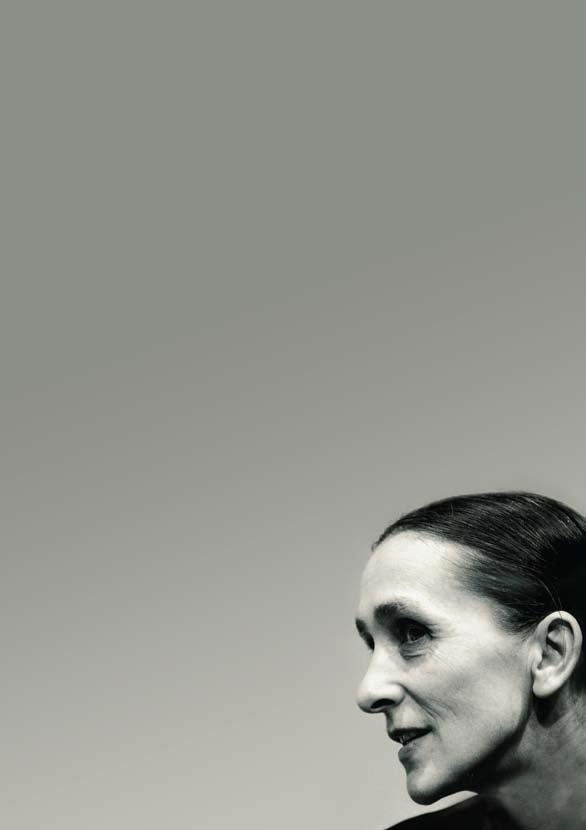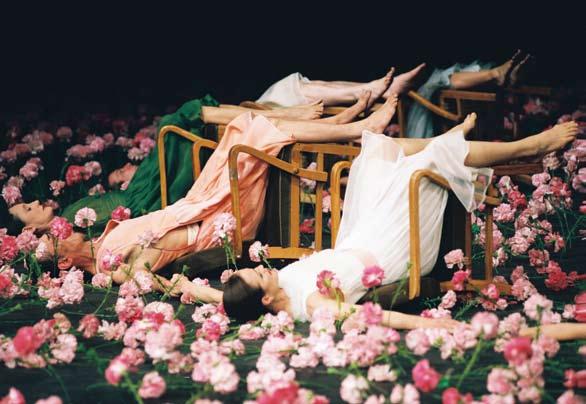11-13.3.2011
香港文化中心大劇院
Grand Theatre
Hong Kong Cultural Centre
演出長約1小時50分鐘,不設中場休息
Running time: approximately 1 hour and 50 minutes with no intervals
演出及創作
翩娜.包殊與烏珀塔爾舞蹈劇場
翩娜.包殊作品年表 The Works of Pina Bausch
特稿
敬請關掉所有響鬧及發光裝置,請勿擅自攝影、錄音或錄影,多謝合作。
Please switch off all sound-making and light-emitting devices. Unauthorised photography or recording of any kind is strictly prohibited. Thank you for your co-operation.
除特別註明,所有照片
Unless otherwise specified, all photographs © Ulli Weiss
特技
約根.克萊恩
米高.莫爾
麥克.史坦麥爾
約根.薩克爾
音樂
舒伯特
歌舒詠
里夏
路易斯.岩士唐
蘇菲.塔克
昆西.瓊斯
陶伯
彩排導演
芭芭拉.考夫曼
多米尼克.默西
羅伯特.斯特姆
芭蕾舞導師
埃德.科特蘭特
技術總監
約克.拉馬舒芬
燈光總監
費爾南多.杰康
燈光助理
克斯丁.哈特(客席)
音響
安德烈亞斯.艾森施奈德
舞台技術人員
狄特里克.雷德
馬田.溫特舒特
舞台監督
費利西塔斯.威廉斯
道具
阿努爾夫.艾希霍爾茨
Stuntmen
Jürgen Klein
Michael Mohr
Mac Steinmeier
Jürgen Sücker
Music
Franz Schubert
George Gershwin
Franz Léhar
Louis Armstrong
Sophie Tucker
Quincy Jones
Richard Tauber
Rehearsal Directors
Barbara Kaufmann
Dominique Mercy
Robert Sturm
Ballet Master
Ed Kortlandt
Technical Director
Jörg Ramershoven
Lighting Director
Fernando Jacon
Lighting Assistant
Kerstin Hardt (as guest)
Sound
Andreas Eisenschneider
Stage Technicians
Dietrich Röder
Martin Winterscheidt
Stage Manager
Felicitas Willems
Properties
Arnulf Eichholz
翩娜.包殊 Pina Bausch (1940-2009)
編舞 Choreographer
翩娜.包殊1940年於德國索林根 出生,2009年病逝烏珀塔爾。她 曾到埃森的福克旺音樂舞蹈學校師 隨庫爾特.佑斯習舞,練就超卓技 巧。1973年秋天獲烏珀塔爾芭蕾 舞團總監阿諾.烏斯坦霍法邀請出 任編舞後不久,將舞團改名為烏珀 塔爾舞蹈劇場。儘管起初頗引人爭 議,烏珀塔爾舞蹈劇場在她的領導 下,逐漸成為享譽國際的藝團。其 糅合詩意和日常生活元素的演出風 格,對全世界的舞蹈發展起了深刻 影響。
翩娜.包殊飲譽國際,獲獎無數, 早已成為當代最重要的編舞家 之一。

Pina Bausch was born 1940 in Solingen and died 2009 in Wuppertal. She received her dance training at the Folkwang School in Essen under Kurt Jooss, where she achieved technical excellence. Soon after the director of Wuppertal Ballet, Arno Wüstenhöfer, engaged her as choreographer, from autumn 1973, she renamed the ensemble the Tanztheater Wuppertal. Under this name, although controversial at the beginning, the company gradually achieved international recognition. Its combination of poetic and everyday elements influenced the international development of dance decisively.
Awarded some of the greatest prizes and honours world-wide, Pina Bausch is one of the most significant choreographers of our time.
三十六年以來,翩娜.包殊不斷打造 烏珀塔爾舞蹈劇場的作品,直至 她2009年離世,成就了一系列以 精準視角注視現實的傑作,同時 賦予了我們忠於一己希冀欲求的 勇氣。她的舞團裏充滿多樣性格的 獨特舞者,他們將會在未來歲月, 一直把這些價值維持下去。
one day be met. Alongside hope, a close engagement with reality is another key to the work; the pieces consistently relate to things every member of the audience knows, has experienced personally and physically.
Over the 36 years in which Pina Bausch shaped the work of the Tanztheater Wuppertal, till her death in 2009, she created an oeuvre which casts an unerring gaze at reality, while simultaneously giving us the courage to be true to our own wishes and desires. Her unique ensemble, with their rich with varied personalities, will continue to maintain these values in the years to come.
Translated from German by Steph Morris
1973 Fritz Dance-evening
Iphigenie auf Tauris Dance-opera
1974 Ich bring dich um die Ecke (I’ll do you in) Popmusic ballet
Adagio Five Songs By Gustav Mahler
1975 Orpheus und Eurydike Dance-opera
Des Frühlingsopfer (The Rite of Spring)
1976 Die Sieben Todsünden (The Seven Deadly Sins)
1977 Blaubart Beim Anhören einer Tonbandaufnahme von Béla Bartóks “Herzog Blaubarts Burg” (Bluebeard While Listening to a Taped Recording of Béla Bartók’s “Duke Bluebeard’s Castle”)
Komm tanz mit mir (Come Dance with Me)
Renate wandert aus (Renate Emigrates) Operetta
1978 Er nimmt sie an der Hand und führt sie in das Schloss, die anderen folgen... (He takes her by the hand and leads her into the castle, the others follow...) In co-production with Schauspielhaus Bochum.
Café Müller
Kontakthof
1979 Arien (Arias)
Keuschheitslegende (Legend of Chastity)
1980 1980 A Piece by Pina Bausch
1981 Bandoneon
1982 Walzer
A co-production with the Holland Festival.
Nelken (Carnations)
1984 Auf dem Gebirge hat man ein Geschrei gehört (On the Mountain a Cry Was Heard)
1985 Two Cigarettes in the Dark
1986 Viktor
A co-production with the Teatro Argentina, Rome.
1987 Ahnen
1989 Palermo Palermo
A co-production with the Teatro Biondo and Andres Neumann International.
1990 Die Klage der Kaiserin (The Plaint of the Empress)
A film directed by Pina Bausch
1991 Tanzabend II
In co-production with Festival de Otoño, Madrid.
1993 Das Stück mit dem Schiff (The Piece with the Ship)
1994 Ein Trauerspiel
In co-production with the Wiener Festwochen.
1995 Danzón
1996 Nur Du (Only You)
A co-production with the University of California in Los Angeles, the Arizona State University, the University of California in Berkely, the University of Texas in Austin and Darlene Neel Presentations and Rena Shagan Associates, Inc. and The Music Center Inc.
1997 Der Fensterputzer (The Window Washer)
A co-production with the Hong Kong Arts Festival Society and the Goethe Institute of Hong Kong.
1998 Masurca Fogo
A co-production with the EXPO 98 Lisbon and the Goethe Institute of Lisbon.
1999 O Dido
A co-production with the Teatro Argentino in Rome and Andres Neuman International.
2000 Kontakthof
With Ladies and Gentlemen over ‘65’
Wiesenland
A co-production with the Goethe Institute of Budapest and the Théâtre de la Ville Paris.
2001 Água
A co-production with Brazil, the Goethe Institute of Sao Paulo and Emilio Kalil.
2002 Für die Kinder von gestern, heute und morgen (For The Children of Yesterday, Today, and Tomorrow)
2003 Nefés
A co-production with the International Istanbul Theatre Festival and the Istanbul Foundation of Culture and Arts.
2004 Ten Chi
A co-production with the Saitama Prefecture, Saitama Arts Foundation and the Nippon Cultural Centre.
2005 Rough Cut
A co-production with the LG Arts Center and the Goethe Institute of Seoul, Korea.
2006 Vollmond (Full Moon)
2007 Bamboo Blues
A co-production with the Goethe Institutes in India.
2008 “Sweet Mambo”
Kontakthof
With Teenagers over ‘14’
2009 “...como el musguito en la piedra, ay si, si, si ...” (Like Moss on a Stone)
In co-production with Festival Internacional de Teatro Santiago a Mil in Chile and with the support of Goethe-Institut Chile. In cooperation with Andres Neumann International.
獻給翩娜,2009年9月4日
For Pina on 9/4/09
文:溫.韋達斯
我們都認識翩娜
所有人都以他或她自己的方式 懷念她
很個人、很內在、很傷痛的懷念
然而我們都有關於她的 一個共同記憶:
或察覺或不察覺── 她那看着我們的目光
假如你曾站或坐在翩娜旁
注視她的眼眸 又或看過她 工作時的神態 看過排練時她如何 觀察她的舞者
你便會明白我所說的是怎樣的目光 可用「翩娜的凝視」為名的目光
只須記起那凝視
她便重現我們眼前 那種起初看來經常 筋疲力倦
然後又打開身體與靈魂, 展示無盡精力的方式 她微微歪着頭 頭髮緊緊梳後 纖巧的輪廓,蒼白的臉龐, 臉上睜着好奇的大眼 帶着半夢幻的神色, 看着世界
總令人覺得她 心不在焉
但其實從未如此
翩娜總在這裏,
就如你會驀然驚覺
By Wim Wenders
We all knew Pina, and every one of us misses her in his or her our own way: very personally, very inwardly, very painfully. But there’s one thing about Pina that all our memories have in common —even if we’re not (yet) aware of it— her look on us.
If you’ve ever stood or sat across from Pina and looked into her eyes, or if you’ve ever watched her while she worked and saw the way she studied her dancers during rehearsal, you know what I mean by this look, by “Pina’s gaze.”
Just recalling that gaze makes her appear right before your eyes again: the way she often seemed tired and exhausted at first and then revealed a body and soul full of sheer endless energy, her head cocked at a slight angle, her hair combed taut and pulled back, her fragile form and pale face with its large curious eyes that seemed to look at the world a bit dreamily, often giving the impression that her thoughts were elsewhere... But they never were. Pina was always present, as you’d notice with a start
她忽然深深凝望你的眼睛 彷彿徹徹底底的 看透了你
伴隨她臉上濃濃的哀愁 郤又隨時準備 展顏綻笑。
過去數星期以來
我讀了多篇翩娜的訪談 不可能不在其中發現 她多麼不信任語言 有時她不斷掙扎, 折磨自己良久
才終於吐出片言隻語 看似簡單
其實不然 世上簡單的事物 早已成為最難處理的
當找不到合適的句子
她常無助地四望 就像可以用眼睛
找到她的答案 正是這證明了 翩娜依仗她的目光 多於文字 起碼她相信 所能看見者
遠多於所能言詮者
瞎子常被認為 擁有敏銳的聽覺 作為失去視力的補償 於翩娜,你幾乎可說她正好相反: 她對文字的不信任 讓她更倚賴她的眼睛 當然是以她
獨特的方式 她把她的凝視化為
非常敏感的工具
用以確認及分析一切
when she’d suddenly gaze deep into your eyes, as if looking through you, at the same time to your bottom, and all with this immense sadness on her face, that was ready to break into a smile at any moment.
Over the last few weeks, I’ve seen and read many interviews with Pina, and it was impossible not to notice in them how little she trusted language. Sometimes she was struggling and tormenting herself to finally say something that was actually quite simple, but then, not at all in a world in which the simple things have long become the hardest to get across.
She would often look around helplessly when she couldn’t find the rights words, as if she might possibly find the answer with her eyes.
That’s where it became evident how much more Pina relied on her look instead of on words. At least she trusted much more in what could be seen than in what could be said.
Blind people are supposed to sharpen their sense of hearing in compensation.
About Pina, you could almost say the reverse: her mistrust of words made her rely all the more on her eyes, but in a very particular, unique way of her own.
She honed her gaze into an extraordinarily sensitive tool for recognising and analysing everything
我們用動作及姿勢 幫助說話、表達 藉此展示關於我們的一切 我們這樣做時, 大抵都是無意識和身不由主 而且大部份不為他人所注意
不過,翩娜一定不是如此 即使我們「置身黑暗中」, 她也能看見 她發展出一套獨特的 姿勢現象學 一種世界觀, 又或者說得更好一點: 一種全新的, 前所未有的 對人性的解釋或詮釋
(……)
正因為她如此關注世人 作為舞蹈及編舞家的她 其藝術並不側重美學、 效果、「美」或吸引力 這些所謂「為藝術而藝術」的東西 而是着重「人之觀照」 刻畫身處特定時代 及社會的人
影響他們的一切狀況 他們的痛苦、恐懼、喜樂及激情 這些刻畫裏還 滲透着幽默 卻從不拿其主人公開玩笑的幽默 這種人文狀況之中 翩娜最廣泛探討的 便是男女關係 她創造了一套名副其實的 姿勢及行為模式系統 以之體現兩性之間的 「遊戲」與「戰爭」
we say and express with our movements and gestures, for everything we reveal about ourselves through them.
We do that involuntarily and unconsciously, and most of it remains invisible to other eyes.
Well, certainly not for Pina. Pina saw, indeed, even when we were “in the dark.”
She developed a unique phenomenology of gestures, a view of the world, so to speak, or even better: an explanation or interpretation of our humanity that was wholly new and unexplored... (…)
Because she had such an interest in people, her great art as a dancer and choreographer was not so much focused on aesthetics, effects, “beauty,” or appeal, - l’art pour l’art so to speakbut rather on an “image of man” (and woman) a depiction of people in their time and their society, subject to all their conditions, pains, fears, joys, and passions. There was an undeniable humour in this portrayal, but it was never “making fun” of their subjects.
The section or aspect of this conditio humana that Pina most extensively explored was the relationship between men and women. She created a genuine anthology of gestures and behavioural patterns to embody both “the game” and “the war” between the sexes.
假如你回溯記憶
想像翩娜再一次凝視你 你會像我一樣
帶着一定程度的悲傷 卻明白你已把那凝視看作理所當然 你已把它看作惟翩娜獨有的 溫柔的觀看方式
我們所有人都無法完全領悟 那是怎麼樣的一種觀看 如夢似幻卻明察秋毫 銳利卻不至於「開膛剖腹」 即使欠缺慰問的話語 卻擁有安撫的力量 穿透你
卻不會令你有變得赤條條的感覺 我們所有人都曉得翩娜已把那凝視 看作理所當然
然而,其實再沒有人會以這種方式 觀看我們
那已超出了個人的損失 那簡直已是歷史的損失
(……)
最後,我想向你們每一位都要求 好好珍惜這你們仍能感受到的 我們仍能感受到的 我們仍能從她作品中追溯得到的 翩娜的凝視 並以滿心的喜悅和歡欣, 在內心保有它
欣賞我們都曾認識翩娜, 認識她的凝視
慶幸我們均曾
經驗到如此無價的禮物
節錄自溫.韋達斯於2009年9月4日 烏珀塔爾劇院
翩娜.包殊追思會上的發言稿 溫.韋達斯,德國電影導演,執導3D電 影《翩娜》(2011)。
If you go back in your memory and imagine Pina’s gaze on you once again, you might realise, as I did, with a certain amount of sorrow, that you took that gaze for granted, that you just saw it as Pina’s very own and tender way of looking.
We all did not grasp what kind of a look that was. Clairvoyant despite its dreaminess, incisive yet not “taking apart,” with an ability to soothe and comfort even if it was lacking the words for that, seeing through you without ever making you feel naked... All of us who knew Pina took that look for granted.
But nobody will ever lay eyes on us like that again.
And this is more than just a personal loss. It is almost a historic one.
(…)
I would like to ask all of you, finally, to cherish this treasure of Pina’s gaze - that you can still feel upon you, that we can still feel upon us, that we can still retrace in her worksand to carry it inside you full of joy and gratitude,
appreciating that you knew Pina, that we all knew her gaze and were fortunate enough to experience such a priceless gift.
Extracted from the speech of Wim Wenders, on September 4, 2009, at the memorial ceremony for Pina Bausch in the Wuppertal Opera House Wim Wenders is a German filmmaker. He directed the 3D film Pina (2011).
花的力量
Flower Power
文:當勞.胡特拉
毫無疑問,翩娜.包殊堪稱二十 世紀後半葉最重要的劇場創作人 之一。這位傳奇編舞家有句一再
引述的名言:「我不在乎人如 何動,我感興趣的是人為何動。」
她的作品殘酷而蒼涼,有時還帶 着專橫的美,但總是如此奪目, 如此戲劇性。1973年她在她祖國 德意志創立了烏珀塔爾舞蹈劇場, 短短數年間,已令藝團所在地從 本來毫不起眼的工業城市,搖身 變成了文化重鎮。
翩娜設計的製作把對話、舞蹈、 心理分析元素、喜劇以及純粹的 恐怖熔接起來,合成巨篇史詩。
其麾下一群充滿氣質和魅力的 舞者,彷彿都能利用他們生命中 最隱藏的秘密,化為進入這些表演 的跳板。每次演出,他們都以一 種近乎懺悔式的忠誠,嘔心瀝血 (有時更以一種反諷的黑色幽默作 為點綴),盡其在我,對有志模仿 翩娜的追隨者來說,早成佳話。
2009年夏天,翩娜求醫確診患上 癌症,五天後竟猝然離世,享年 68歲。儘管一切來得如此突然, 她對全世界創作人(由羅伯特. 威爾遜、安.德麗莎.迪.姬爾 斯美嘉、比爾提瓊斯、彼得.胥 坦到威廉.佛賽、洛伊.紐森、 亞.布拉德勒及西迪拉比.沙爾卡 維等……不一而足)的影響,仍是 不可估量。
By Donald Hutera
Pina Bausch was unquestionably one of the key theatrical innovators of the second half of the 20th century. “I’m not interested in how people move,” the legendary choreographer and director once famously remarked, “but what moves them.” In 1973 she founded the Tanztheater Wuppertal in her native Germany. Within a few short years her work — frequently brutal and bleak, sometimes marked by a magisterial beauty, but always arrestingly theatrical — put the unprepossessing industrial city her company called home firmly on the world cultural map.
The productions Bausch devised welded dialogue, dance, elements of psychoanalysis, comedy and sheer terror into grandiose, outsized epics. Her international company of marvellously idiosyncratic and charismatic dancer-actors seemed to use the innermost secrets of their lives as the springboard into these performances. They busted their guts both physically and emotionally with an almost confessional honesty (sometimes flecked with a dark, ironic humour) that gradually became a byword for a legion of Bausch imitators.
Bausch died unexpectedly five days after being diagnosed with cancer in the summer of 2009, aged 68. Despite this shockingly sudden loss, her influence on other creative artists worldwide — from Robert Wilson, Anne Teresa De Keersmaeker, Bill T Jones and Peter Stein to William Forsythe, Lloyd Newson, Alain Platel and Sidi Larbi Cherkaoui, to name just a few — is incalculable.
童年記憶。全劇瀰漫如夢似幻的 氣氛,一種「讓我們假裝一下」 的意味。舞者用洋葱抹臉以致淚 流披面,特技人從搭架上跳進紙 牆……在在顯示這是一個充滿潛 在暴力與虛假警報的世界。這看 似散漫、重複及儀式性的表演, 充滿無情的恐懼意識和快活的浪漫 情調,是一闕頌歌,大膽向失落的 純真及無人能免疫的欲望與錯覺 致敬。
當勞.胡特拉是倫敦《泰晤士報》、《歐洲舞 蹈雜誌》以及其他多份刊物和網站的作者。
本文原載於2010年《閱藝》雜誌。
was no more charitable or optimistic. In the bittersweet Nelken, moments of tender intimacy and playful, even surreal humour offset the currents of cruelty, chaos and pain. Some have suggested that in making it Bausch was drawing upon memories of her own childhood in the aftermath of World War Two. There is a dream-like aura of “let’s pretend” to the show. That this is a world of potential violence and false alarm is evident in the tears produced when dancers rub their faces with chopped onions, or in the daring stunt men who dive off scaffolding into walls of cardboard. Shot through with grim menace and blithe romance, this deceptively rambling, repetitive and ritualistic performance is an audacious paean to lost innocence and the desires and delusions to which we are all susceptible.

彼得.帕布斯特
Peter Pabst 舞台設計 Set Designer
1944年於波蘭出生,柏林長大並學習縫紉,後到科隆修習服裝及佈景設計。
起初參與戲劇、歌劇及電影製作,未幾即與國際級導演合作。1980年應

翩娜.包殊所邀擔任烏珀塔爾舞蹈劇場舞台設計至2009年。與翩娜.包殊合 作無間的歲月裏,他設計的空間有禁閉壓抑的,也有恢宏大氣的,於不經意 間流露戲劇性。每一次由他設計的舞台都為舞蹈劇場打開了詩意的向度,讓觀眾享有夢想的 空間,產生如魔術的表達效果,為藝團蜚聲國際作出了顯著的貢獻。
Pabst, born 1944 in Grodzisk Wielkopolski, grew up in Berlin and began learning tailoring, then studied costume and set design in Cologne. He started his career in theatre, opera and film, soon working with internationally renowned directors. In 1980 Pina Bausch recruited him as set designer for the Tanztheater Wuppertal, where he remained till 2009. It was soon clear that they formed a perfect team. Peter Pabst’s spaces varied from the ascetic to the spectacular, as dramatic as they were unpretentious. Each set opened up a poetic dimension to dance theatre, allowing the audience space to dream, and developed a magic and expressiveness which contributed significantly to the company’s international success.
瑪里恩.西圖
Marion Cito
服裝設計 Costume Designer
1938年生於柏林,師隨塔堤娜.格蘇夫斯基接受舞蹈訓練,並獲恩師賞 識邀入柏林德意志歌劇院工作。1972年往達姆斯塔特與蓋哈特.伯納合 作。1976年應翩娜.包殊邀請出任其助理,同時擔任舞者。1980年藝團

舞台及服裝設計羅爾夫.博扎克辭世後接任服裝設計,把博扎克的美學進 一步開拓發展,持續探索高貴與日常之間的微妙平衡,確保烏珀塔爾舞蹈劇場的演出保持 色彩繽紛,感覺豐富。
Cito, born 1938 in Berlin, completed her dance training in her hometown under Tatjana Gsovsky, who subsequently employed her at the Deutsche Oper. From 1972 she worked with Gerhard Bohner in Darmstadt, before Pina Bausch took her on in 1976 as her assistant at the Tanztheater Wuppertal, where she also appeared as a dancer. Following the death of the set and costume designer, Rolf Borzik, in 1980, she took over costumes, extending and developing Borzik’s aesthetic approach. She persistently explores the delicate balance between elegance and the everyday and ensures that the company’s appearance remains colourful and sensuously rich.
場刊中譯:朗天
協作及統籌 Collaboration and Organisation
Katharina Bauer
Grigori Chakhov
Claudia Irman
Peter Lütke
Ursula Popp
Ina Zentner
傳媒及公關 Press and Public Relations
Ursula Popp
巡演統籌 Tour Organisation
Claudia Irman
巡演監督 Tour Management
Felicitas Willems
舞台監督 Stage Manager
Felicitas Willems
Peter Lütke
鋼琴 Pianist
Matthias Burkert
攝影協作 Photographic Collaboration
Ulli Weiss (guest)
錄像選編 Collaboration Video
Grigori Chakhov
檔案 Archiving
Marc Wagenbach
檔案選編 Collaboration Archiving
Bénédicte Billiet
Barbara Kaufmann
Grigori Chakhov
技術總監 Technical Directors
Manfred Marczewski
Jörg Ramershoven
燈光總監 Lighting Director
Fernando Jacon
燈光助理 Lighting Assistants
Jo Verlei
Kerstin Hardt (guest)
Lars Priesack (guest)
舞台技術人員 StageTechnicians
Dietrich Röder
Martin Winterscheidt
音響 Sound
Andreas Eisenschneider
Karsten Fischer
道具及採購 Properties and Merchandising
Jan Szito
Arnulf Eichholz
服裝 Wardrobe
Harald Boll
Silvia Franco
Andreas Maier
Katrin Moos
Ulrike Schneider
指壓治療師 Shiatsu Therapist
Ludger Müller
